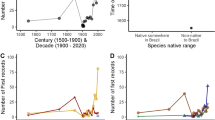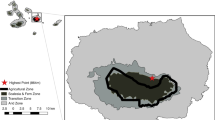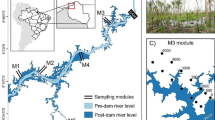Abstract
Castor canadensis specimens were imported from Canada and released in the wilderness on the Argentinean part of Tierra del Fuego (TDF) in the year 1946. First studies on the development of the beaver population and subsequent environmental changes were conducted four decades later and indicated a strong expansion of these animals, with negative effects on the forest, especially the dominant Nothofagus sp. Between 1999 and 2001, we investigated the density of the beaver population in the Chilean part of TDF and the southern adjacent island Navarino (NAV). Data were mapped into a geographical information system. The mean colony density was 1.03 (range: 0.15–1.91) and 1.1 per km watercourse for 75% of the area of TDF (mainly south and central region) and the total NAV island, respectively. The average number of individuals estimated per colony was five. Based on these findings, the number of beavers in the Chilean part of TDF and on NAV was estimated at 61,300 individuals. The population is increasing and expanding in the Northern region, with a linear rate of 2.6–6.3 km/year.

Similar content being viewed by others
References
Anderson CB, Griffith CR, Rosemond AD, Rozzi R, Dollenz O (2006) The effects of invasive North American beavers on riparian plant communities in Cape Horn, Chile: do exotic beavers engineer differently in sub-Antarctic ecosystems? Biol Conserv 128:467–474
Breck S, Wilson K, Andersen D (2001) The demographic response of bank-dwelling beavers to flow regulation: a comparison on the Green and Yampa Rivers. Can J Zool 79:1957–1964
Briones M, Schlatter R, Wolodarsky A, Venegas C (2001) Classificación ambiental para hábitat de Castor canadensis (Kuhl 1820, Rodentia), de acuerdo a características de cuencas en un sector de Tierra del Fuego. Anal Inst Patagonia (Chile) 29:75–93
Hartman G (1994) Long-term population development of a reintroduced beaver (Castor fiber) population in Sweden. Conserv Biol 8:713–717
Hartman G, Axelsson A (2004) Effect of watercourse characteristics on food-caching behaviour by European beaver, Castor fiber. Department of Conservation Biology, Swedish University of Agricultural Sciences, Sweden. Number: 7435R. Available at: http://www.nvb.slu.se, last accessed 2004-21-02
Härkönen S (1999) Forest damage caused by the Canadian beaver (Castor canadensis) in South Savo, Finland. Silva Fennica 33:247–259
Jaksic FM (1998) Vertebrate invaders and their ecological impacts in Chile. Biodiv Conserv 7:1427–1445
Jaksic FM, Iriarte A, Jiménez JE, Martínez DR (2002) Invaders without frontiers: cross-border invasions of exotic mammals. Biol Invasions 4:157–173
Kinzelbach R, Sommer R (2001) Neue Tiere in Deutschland, Steckbriefe: Biber-Castor fiber Linnaeus, 1758. University of Rostock, Germany, p 2
Lizarralde MS (1993) Current status of the introduced beaver (Castor canadensis) population in Tierra del Fuego, Argentina. Ambio 22:352–358
Lizarralde MS, Deferrari G, Escobar J, Alvarez S (1996) Estado de la pobalción de Castor canadensis introducida en teirra del fuego y su estudio cormosómico. Project Conicet PID-BID 50/52, p 18
McTaggart ST, Nelson TA (2003) Composition and demographics of beaver (Castor canadensis) colonies in central Illinois. Am Midland Nat 150:139–150
Mella J, Saavedra B (1995) Mamíferos con incidencia en el bosque: castores. In: Proyecto río Cóndor, Forestal Trillium Ltda. Estudio de impacto ambiental. Comisión científica Proyecto Río Cóndor y Dames & Moore, subproyecto pp 94–14
Novak M (1987) Beaver. In: Novak M, Baker JA, Obbard, ME, Malloch B (eds) Wild furbeaver management and conservation in North America. Ashton-Potter, Ontario, Canada, pp 283–312
Nummi P (2000) Alien species in Finland, Ministry of environment, p.26–27. Available at: http://www.ymparisto.fi/download. asp?contented=34577&lan=en, last accessed 2006-01-01
Payne NF (1984) Mortality rates of beaver in Newfoundland. J Wildl Manage 48:117–126
Schwab G, Lutschinger G (2001) The return of the beaver (Castor fiber) to the Danube watershed. In: Czech A, Schwab G (eds) The European Beaver in a new millennium. Proceedings of 2nd European Beaver Symposium, 27.-30.9.2001. Carpathian Heritage Society, Krakow, pp 47–50
Sielfeld W, Venegas C (1980) Poblamiento e impacto ambiental de Castor canadensis Kuhl, en la Isla Navarino, Chile. An Inst Patagon 11:247–257
Skewes O, González F, Rubilar M, Quezada R, Olave R, Vargas V, Ávila A (1999) Investigación, aprovechamiento y control del castor en islas Tierra del Fuego y Navarino. Informe Final, Servicio Agrícola y Ganadero (SAG), XII Región, p 185
Smith D (1998) Beaver survey Yellowstone National Park. YCR-NR-99-3. Yellowstone Center for Resources. Available at: http://www.nps.gov/yell/nature/animals/beaver/beaver98.pdf, last accessed 2005-06-28
Acknowledgements
This study was supported in part by Gobierno Regional XII Región, Magallanes Y Antártica Chilena, Gobierno De Chile. We also wish to thank Nicolás Soto and to Edmundo Schuster for his help in the field.
Author information
Authors and Affiliations
Corresponding author
Rights and permissions
About this article
Cite this article
Skewes, O., Gonzalez, F., Olave, R. et al. Abundance and distribution of American beaver, Castor canadensis (Kuhl 1820), in Tierra del Fuego and Navarino islands, Chile. Eur J Wildl Res 52, 292–296 (2006). https://doi.org/10.1007/s10344-006-0038-2
Received:
Accepted:
Published:
Issue Date:
DOI: https://doi.org/10.1007/s10344-006-0038-2




